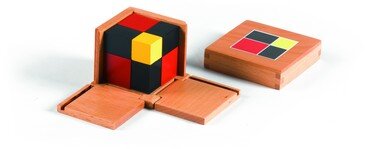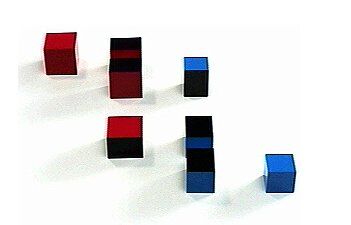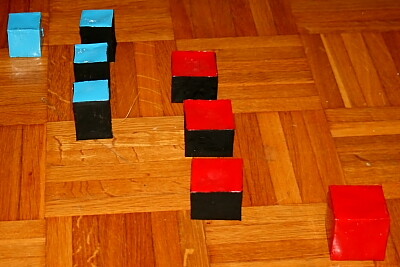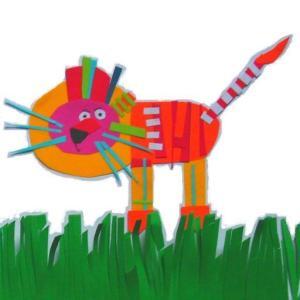Il cubo del binomio Montessori è un materiale che viene presentato come materiale sensoriale nella casa dei bambini, per essere poi ripreso nella scuola primaria nell’ambito dello studio dell’algebra.


Contenuto:
1 cubo blu,
1 cubo rosso,
3 blocchi neri e blu,
3 blocchi neri e rossi.
Tutti i blocchi si inseriscono in un contenitore in legno con coperchio e lati removibili. Il coperchio contiene un modello guida.
Gli otto 8 blocchi si incastrano in un modello binomiale, formando una rappresentazione concreta della formula algebrica (a + b) ³.
I fattori dell’equazione sono rappresentati dai cubi colorati e prismi. (a+b)³ = a³+3 a²b+3 ab²+b³
I bambini più piccoli possono esplorare il cubo del binomio come attività sensoriale di discriminazione visiva del colore e della forma. Questo può servire come preparazione indiretta per l’algebra e la matematica.
Cubi:
1 cubo 4x4x4 rosso
1 cubo 3x3x3 blu
parallelepipedi:
3 parallelepipedi 4x4x3 rossi e neri
3 parallelepipedi 3x3x4 blu e neri
(tutte le facce 4×4 sono rosse, tutte le facce 3×3 sono blu, tutte le facce 3×4 sono nere).

qui il tutorial per realizzare il cubo del binomio in proprio: cubo del binomio tutorial
_____________________________
Presentazione
Materiale necessario:
un cubo di binomio
Presentazione:
1. L’insegnante invita il bambino ad unirsi a lei nell’esercizio,
2. quindi porta la scatola al tavolo e siede accanto al bambino, al suo lato non dominante.
3. Toglie il coperchio e lo pone accanto al cubo con il disegno visibile in alto. Poi estrae dalla scatola i quattro lati, permettendo al bambino la visione del cubo del binomio. Naturalmente se non avete una scatola coi lati removibili, dovrete estrarre il cubo del binomio e posizionarlo sul tavolo.
4. Per osservare il cubo in tutte le sue facce visibili, ci alziamo insieme e facciamo un lento giro del tavolo.
5. Insegnante e bambino siedono di nuovo e lentamente l’insegnante scompone il cubo: prima toglie insieme i quattro blocchi che formano lo strato superiore del cubo e lo appoggia così com’è davanti al bambino.
6. Poi isola il cubo rosso, a seguire i parallelepipedi neri e rossi (a destra del cubo rosso), poi i parallelepipedi neri e blu, e infine il cubo blu.
7. Dopo un tempo dedicato all’osservazione, l’insegnante ricostruisce il cubo, iniziando col cubo rosso per finire con il cubo blu. Tutti i colori laterali devono corrispondere.
8. Il bambino può ripetere l’esercizio.
Quando si utilizza questo materiale, l’insegnante e quindi il bambino utilizzano sempre il nome corretto di ogni parte che lo compone, si parlerà dunque di cubo del binomio, di cubo e di parallelepipedo.
